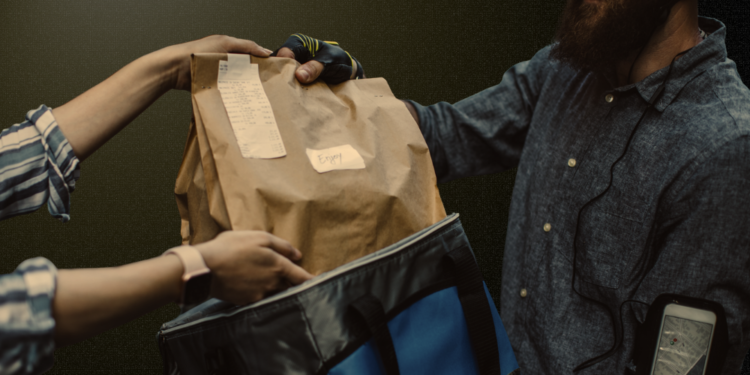What used to take a stove, a family recipe, and an hour in the kitchen can now be summoned with three taps and a Wi-Fi signal.
In the Philippines, food delivery apps haven’t just changed what’s on the table — they’ve rewritten the entire ritual of eating.
The dining room is still there, but instead of a steaming pot of sinigang, it’s ringed with milk tea cups, pizza boxes, and fried chicken buckets from three different restaurants. How did a nation built on shared, home-cooked meals trade ladles for logistics?
Cravings now arrive by courier
Food delivery apps have rewritten Filipino mealtime culture, turning the act of eating into an on-demand experience where cravings can be satisfied with a few taps.
Foodpanda and GrabFood, the country’s leading platforms, entered the scene in the mid-2010s and became household names by the pandemic’s peak, when lockdowns kept people indoors and restaurants shut for dine-in service.
By 2021, the food delivery sector generated ₱55 billion in revenue, and about one-third of all meals eaten by Filipinos were already ordered from restaurants rather than cooked at home. GrabFood’s active user base doubled in 2020 compared to 2019, showing how quickly digital ordering became a default.
A columnist observed that “eating at home [via delivery] is now ingrained in our DNA” after living through months of restrictions. Even after dining rooms reopened, seven in ten Filipinos said delivery remained a permanent part of their post-pandemic habits, not just a lockdown workaround.
Family meals replaced by multi-restaurant menus
For decades, the Filipino family dining table meant home-cooked meals prepared and eaten together. Delivery apps didn’t erase the table — they changed what’s on it. Families with children are now the primary customers for home delivery in the Philippines.
Over half of app users are married with kids, and by 2021, 78% of online food orders were intended for sharing among several people, not solo consumption.
Instead of one big pot of adobo, dinner might now include fried chicken, sushi, and milk tea — all in the same sitting. This flexibility has become part of family dining culture, allowing members to satisfy individual preferences without cooking multiple dishes.
Home gatherings have also shifted toward ordering in: two in five consumers now prefer to host with delivered food instead of dining out, and large residential weekend orders have surged by 500% in two years.
Even merienda — the Filipino afternoon snack — has been pulled into the delivery economy. Orders between 3–6 PM now have the highest basket value on GrabFood, with group treats like milk tea and pastries driving the spend.
Convenience shaped a culture of instant dining decisions
The success of food delivery apps isn’t just about food — it’s about time and access. With Manila’s infamous traffic and long work hours, skipping the commute to a restaurant is a huge draw. The top reasons Filipinos cite for using delivery apps include no time to cook, wanting food they can’t prepare themselves, and avoiding travel and parking hassles.
Meal planning has become more impulsive. Half of customers say they choose what to eat based on what looks appealing while browsing the app. 74% of users scroll with no specific restaurant in mind, and 89% use the app to discover new places they’ve never tried. People now treat these platforms like a “food search engine,” often spending 15–20 minutes browsing before deciding.
This shift has expanded culinary exposure. Cake orders on GrabFood grew 2.6× in 2020, “pizza” logged over six million searches, and milk tea remained a top-searched craving.
The trade-offs for health and nutrition
On-demand dining often caters to indulgence. The most popular orders among Filipinos include fried chicken, burgers, sweet drinks, and milk tea. Nutrition experts warn that regular consumption of ultra-processed foods — common in delivery menus — increases risks of obesity, diabetes, and cardiovascular disease. Aggressive promotions, combo meals, and upsells in apps encourage larger, less healthy orders.
Food safety is another concern: mishandling during delivery has led to cases of spoiled or contaminated food.
Still, demand for healthier meals is growing. Three in four consumers say they want to eat healthy and would pay more for nutritious options, leading to a 400% increase in orders from health-focused restaurants.
Restaurants rebuilt for the delivery-first era
This dining shift has also reengineered the food business.
Many restaurants now run “dark kitchens” — spaces dedicated solely to preparing delivery orders — and design menus for travel rather than table presentation. For some eateries, the app listing is more important than the physical storefront, since a customer’s first interaction is often a digital photo carousel, not a host at the door.
A dining revolution that will outlast the hype
Urban middle-class Filipinos, particularly Gen Z and millennials, see delivery apps as everyday utilities. For them, the convenience and variety outweigh the fees. While low-income households participate less due to costs and connectivity barriers, the on-demand model is embedded in how the majority now eat.
The Filipino dining table still stands — but it’s often surrounded by boxes from different restaurants, each a testament to personal choice and collective convenience. Food delivery apps haven’t killed the tradition of eating together; they’ve reprogrammed it for the digital age, replacing home-cooked unity with multi-tabbed menus and algorithm-driven cravings.
And based on the numbers, this appetite isn’t going away anytime soon.











